European Neighbourhood Policy - South - education statistics
Data extracted in March 2023.
Planned article update: April 2024.
Highlights
Public expenditure on education relative to GDP in 2021, was higher in Israel (7.1 %) than in the EU (4.8 %).
The highest rates of youth educational attainment for men and women in 2021, in the European Neighbourhood Policy-South countries were in Israel with 91.5 % and 95.4 %, respectively.
Between 2011 and 2021, Palestine recorded the largest increase in the proportion of women aged 25-64 years to have completed tertiary education (+11.9 %) among the European Neighbourhood Policy-South countries.
Adult literacy rate by gender, 2021
This article is part of an online publication and provides data on education statistics for eight of the countries that form the European Neighbourhood Policy-South (ENP-South) region — Algeria, Egypt, Israel, Jordan, Lebanon, Morocco, Palestine [1] and Tunisia; no recent data are available for Libya or Syria. Recent developments for education statistics in these countries and in the European Union (EU) are presented. The article shows, among others, statistics on literacy rates, public expenditure on education, youth educational attainment and tertiary education.
Full article
Public expenditure on education
Public expenditure on education as a share of GDP provides a measure of the relative importance given by governments to spending on education. Data for only four ENP-South countries are available regarding public expenditure on education (see Figure 1). Among these countries, Egypt had the lowest share of public expenditure on education with 3.1 % in 2017 (more recent data not available) and 3.9 % in 2011. Tunisia's public expenditure on education was 5.4 % in 2020 (no 2011 nor 2021 data available). Morocco's public expenditure on education was 4.2 % in 2016 (more recent data not available) and 4.9 % in 2011. The highest ratio was found in Israel where 7.1 % of their expenditure went towards education in 2021; it was estimated at 6.9 % in 2020 and 6.1 % in 2011. Furthermore, public spending on education, as a share of GDP, was higher in Israel than in the EU where it was 4.8 % in 2021, 5.0 % in 2020 and 4.9 % in 2011.
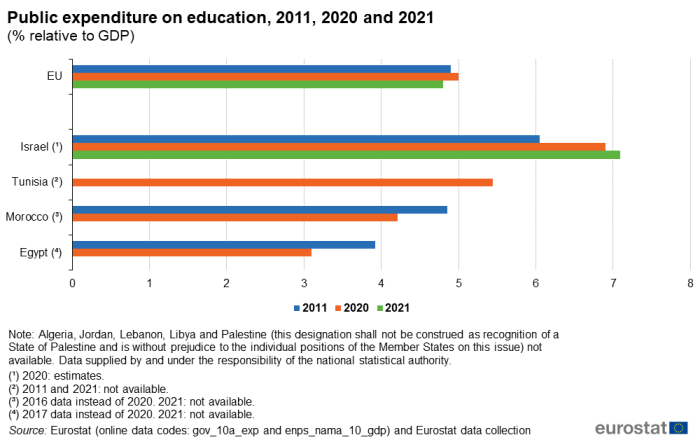
(% relative to GDP)
Source: Eurostat (gov_10a_exp) and (enps_nama_10_gdp) and Eurostat data collection
Literacy rates
In this article, literacy is considered as the ability to both read and write, with understanding, a short simple statement on everyday life. Figure 2 presents the ratio of adult literacy by gender. The information shown reveals, as a general trend that women literacy rates were much lower than men literacy rates in most of the ENP-South countries. This was particularly true for those countries which had lower overall adult literacy rates, such as Morocco where in 2016 (more recent data not available), 74.6 % of men were able to read or write, compared with only 51.3 % of women. Egypt had the second lowest literacy rate and the second highest gender gap literacy with 76.4 % of men and 65.4 % of women in 2017 (more recent data not available). Data for Tunisia and Algeria are not available for recent years, however, they respectively had, 87.9 % in 2011 and 82.4 % in 2008 (2011 data not available) of men literacy while they had 71.8 % and 67.3 % of women literacy, respectively. Men literacy rate in Lebanon was 94.8 % in 2018 (more recent data not available), while the women rate was 89.5 %. In Jordan, 95.3 % of men in 2018 (more recent data not available) and 91.4 % of women were literate. Palestine shares of literate adults were recorded to be very high; in 2021, 98.8 % of men and 96.5 % of women were literate. However, the highest adult literacy ratios for both genders were reported in Israel, with 99.3 % men and 98.2 % women in 2021.
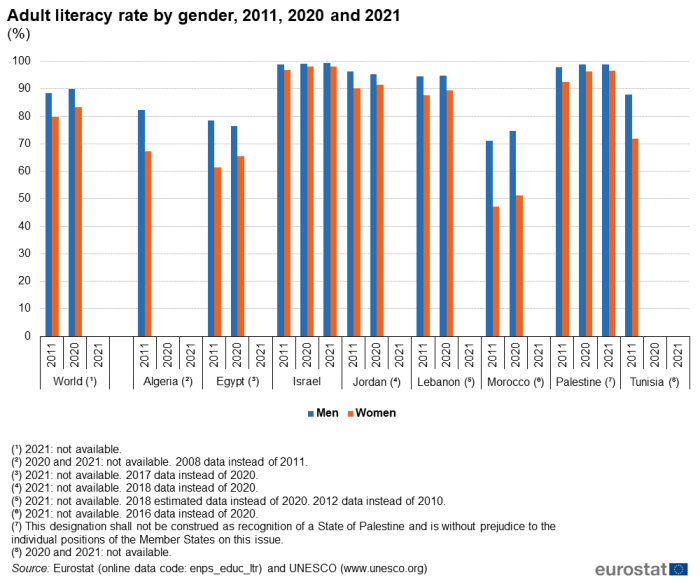
(%)
Source: Eurostat (enps_educ_ltr) and UNESCO (www.unesco.org)
Within the ENP-South countries where both 2011 and 2021 (or most recent year) data were available, most ratios showed an increase in the rate of adult literacy over the period. While Morocco recorded the lowest rates in 2016, it was also found that they reported the biggest increase in adult literacy; where between 2011 and 2016, the men literacy share increased by 3.6 percentage points (pp) and the women by 4.1 pp. In Palestine, the women literacy rate increased more than four times faster (+3.9 pp) than the men literacy rate (+0.9 pp) between 2011 and 2021. The literacy rates also increased in Israel by 0.5 pp and 1.3 pp for men and women, respectively, over the period 2011-2021. In Egypt and Jordan, there was a decline in adult men literacy, by 2.0 pp (between 2011 and 2017) and 1.1 pp (between 2011 and 2018), respectively. Yet, both countries saw an increase in adult women literacy rate with 3.9 pp more literate women in 2017 compared with 2011 in Egypt and 1.3 pp more in Jordan between 2011 and 2018.
Across the world an estimated 90.1 % of men were able to read or write in 2020 (no 2021 data available), according to the UNESCO Institute for Statistics. By contrast, for women the adult literacy rate was 83.3 %. Therefore, among the ENP-South countries, only Egypt and Morocco reported values of adult literacy that were below the world average in 2020.
Net enrolment rates
Net enrolment rates among the ENP-South countries for primary education (classified according to the International Standard Classification of Education (ISCED) level 1) were higher than 85 % in 2021 or more recent year available (see Figure 3). The lowest rate among those ENP-South countries for which data are available was recorded in Jordan (86.0 % for men and 87.1 % for women; 2018 data) and in Lebanon (86.7 % for men and 87.7 % for women; 2018 data). Data for the EU are not available.
In most ENP-South countries, there were small differences between the genders with regards to the enrolment of men and women in primary education. In Egypt, the share of men enrolled in primary education (95.2 %) in 2018 (more recent data not available) was 3.5 pp lower than the corresponding share for women (98.7 %); making it the biggest gender gap in favour of girls among the ENP-South countries in recent years. A higher gender gap in favour of girls was found in Lebanon, but in 2011 (5.5 pp). In Israel, 93.5 % of men were enrolled in primary education and 94.4 % of women in 2021; a gender gap of 0.9 pp. A similar gender gap was found in Jordan in 2018 (more recent data not available): 1.2 pp gender gap in favour of women.
Lebanon's large gender gap in the enrolment in primary education significantly lowered over the decade, reaching an estimated 1.0 pp in 2018 (more recent data not available), with an estimated 86.7 % of men and 87.7 % of women. The situation in Morocco, Palestine and Tunisia was similar in the sense that all three countries in 2011 had higher levels of males than females enrolled in primary education, while the ratios reversed in 2021. In 2011, Morocco reported 97.2 % of men and 96.7 % of women in primary education (0.5 pp gender gap), as opposed to 99.8 % of males and 99.9 % of females in 2020 (0.1 pp gender gap). Morocco was also the country that reported the overall highest rate of primary education enrolment (regardless of gender) among the ENP-South countries, for which data was available. Palestine's gender gap was 1.0 pp in favour of boys in 2011 and 0.6 pp in favour of girls in 2021, with 96.2 % of men and 96.8 % of women enrolled in 2021. Tunisia's enrolment rates were also rather stable over the 10-year period with 97.8 % of men and 97.4 % of women in 2010 (no 2011 data available); 0.4 pp in favour of boys. The gender gap changed 0.2 pp in favour of girls in 2021 with 99.1 % of men and 99.3 % of women enrolled.
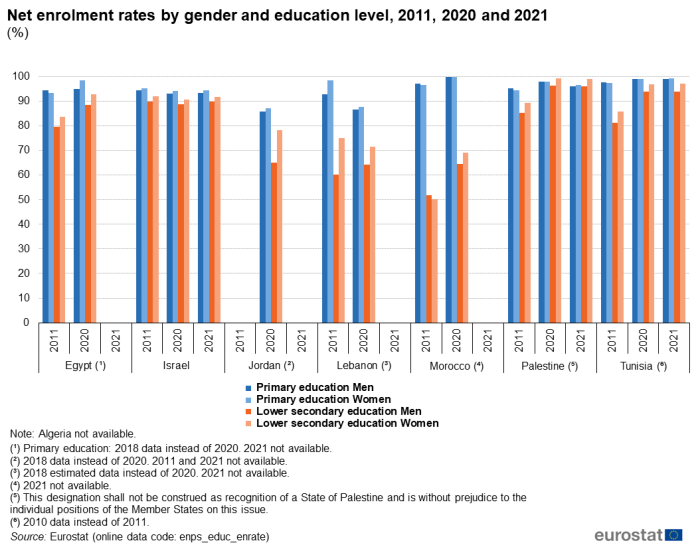
(%)
Source: Eurostat (enps_educ_enrate)
The ENP-South countries for which data is available recorded an increase in enrolment rates for both men and women between 2011 and 2021, with the exception of Israel and Lebanon. In Israel, there was a decrease in children enrolment in primary education over the period by 1.1 pp for men and 1.0 pp for women while in Lebanon, a 6.3 pp decline (between 2010 and 2018) was estimated for men and a strong 10.8 pp fall (between 2011 and 2018) was estimated for women.
By contrast, enrolment in primary education in Tunisia increased by 1.3 pp and 1.9 pp for men and women, respectively, between 2010 (no 2011 data) and 2021. Morocco and Palestine saw increases in enrolment rates with 2.6 pp and 0.8 pp for men, respectively, and 3.2 pp and 2.3 pp for women between 2011 and 2021 (2020 for Morocco). In Egypt, there were increases by 0.6 pp for men and 5.2 pp for women between 2011 and 2018 (more recent data not available).
In each of the ENP-South countries for which data are available, a smaller proportion of children were enrolled in lower secondary education (ISCED level 2), which generally starts around the age of 11 or 12 and lasts for three to five years, than in primary education. All ENP-South countries showed enrolment rates that were higher for women than for men, with the exception of Morocco in 2011. The highest net enrolment rates for lower secondary education were recorded in Palestine, with 96.1 % for men and 99.0 % for women, after increasing by 10.8 pp and 9.7 pp compared with 2011, respectively. By contrast, the lowest rates were recorded in Morocco and Lebanon, 64.5 % in 2020 (more recent data not available) and 64.3 % in 2018 (more recent data not available) for boys, 69.1 % in 2020 (more recent data not available) and 71.5 % in 2018 (more recent data not available) for girls respectively. The rates in Morocco showed a 12.7 pp and 18.8 pp increase from 2011 for boys and girls, respectively; the strongest growth amongst the ENP-South countries. In 2021 compared with 2010 (2011 data not available), the second highest increase recorded was in Tunisia with 12.7 pp and 11.3 pp increase, respectively, to 94.0 % for boys and 97.1 % for girls. Substantial increases were also observed in Egypt between 2011 and 2018 (more recent data not available), with +8.9 pp for boys and +9.2 pp for girls.
The ENP-South countries, for which data are available, all reported an increase in the enrolment rates in lower secondary education between 2011 and 2021 (or most recent year available), except for Israel where there were 0.1 pp decrease in men enrolments and 0.3 pp decline in women enrolments. Another exception was women enrolments in Lebanon, which declined by 3.5 pp between 2011 and 2018 (more recent data not available), whereas men enrolment rates increased by 4.2 pp over the same period. The rest of the ENP-South countries reported a growth in these rates. No recent data were available for Jordan enrolment rates, but it reported 65.1 % for men and 78.4 % for women in 2018.
Youth educational attainment
Figure 4 presents the share of the population aged 20-24 that attained at least an upper secondary educational level (ISCED level 3) — referred to as the youth education attainment level.
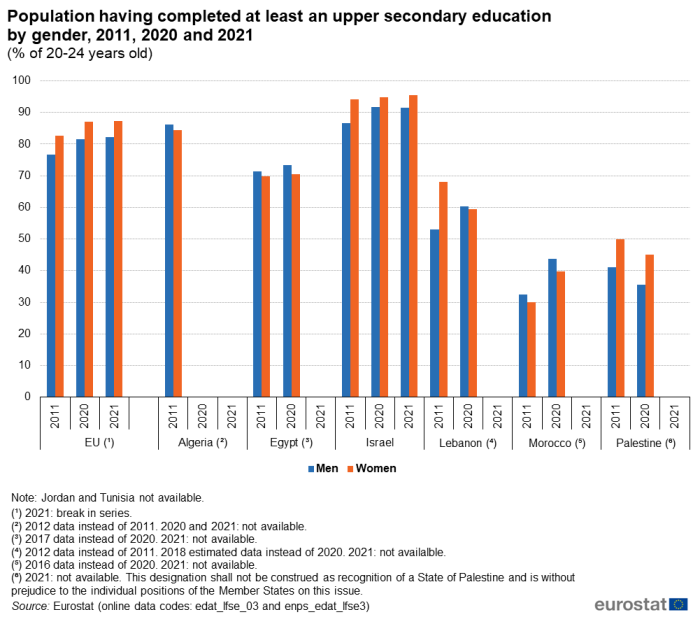
(% of 20-24 years old)
Source: Eurostat (edat_lfse_03) and (enps_edat_lfse3)
Among the ENP-South countries for which data is available, the highest rate of youth educational attainment for men and women was reached in Israel with 91.5 % and 95.4 % in 2021, respectively. Palestine recorded the biggest gender gap (9.5 pp) in favour of young women for this level of educational attainment in 2020 (2021 not available). In 2011, the gender gap was 14.9 pp for Lebanon, while it was estimated that in 2018 (more recent data not available) 0.8 pp fewer women, compared with men, attained youth education. The next largest gender gaps were found in Palestine and Israel in 2011, where, 8.9 pp and 7.5 pp respectively, more women had completed at least an upper secondary education. In 2021, in Israel this gap lowered to 3.9 pp difference. The other ENP-South countries reported a higher rate of male youth educational attainment than female over the decade. Egypt and Morocco were the countries that revealed a gender gap in favour of men in both 2011 and 2020. In Egypt, this gender gap increased from 1.5 pp in 2011 to 3.0 pp in 2017 (more recent data not available), while Morocco recorded the biggest gap in favour of young men, with 4.1 pp in 2016 (more recent data not available) and 2.6 pp in 2011. There is no recent data for Algeria, however, it can be noted that in 2012 (no 2011 data), the gender gap was 1.8 pp in favour of young men.
In the EU, the gender gap was in favour of women over the whole decade, with 5.2 pp difference in 2021 while it was 5.9 pp in 2011. In 2021, 82.1 % of men had completed at least an upper secondary education, while the same year, 87.3 % of women had attained that level. A decade earlier, these levels were lower with 76.7 % for men and 82.6 % for women.
Tertiary education
As shown in Figure 5, the overall proportions of the population aged 25-64 years to have completed tertiary education (ISCED levels 5-8) have increased between 2011 and 2021 in all ENP-South countries for which data are available and regardless of the gender. Among the ENP-South countries for which data are available, the highest proportion of the 25-64 years population that had obtained tertiary education was registered in Israel, with 44.5 % of men and 51.6 % of women in 2021. The gender gap in tertiary education in Israel increased from 4.3 pp in 2011 to 7.1 pp in 2021 in favour of women.
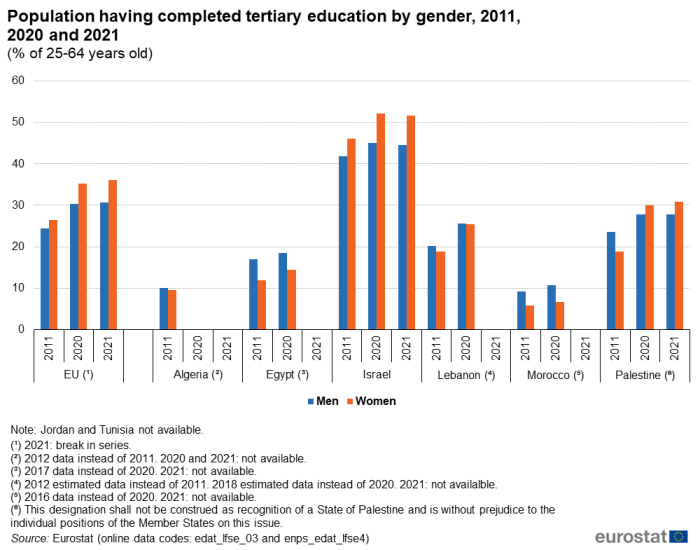
(% of 25-64 years old)
Source: Eurostat (edat_lfse_03)
The second highest rates were observed in Palestine, where 27.8 % of men had attained tertiary education in 2021 and 30.8 % of women. The gender gap was 3.0 pp higher for women in 2021, as opposed to being 4.6 pp in favour of men in 2011. In Lebanon, men accounted for 25.5 % of the 25-64 years population to have attained tertiary education in 2018 (more recent not data available), while women accounted for 25.4 %. The proportion of Lebanese men at this level of education was slightly higher than the proportion of women in 2018 (0.1 pp), in 2012 (no 2011 data) it was recorded 1.4 pp difference in favour of men. In Egypt, 4.0 pp more men (18.5 %) than women (14.5 %) had completed tertiary education in 2017 (more recent data not available). There is no recent data for Algeria, however, it can be noted that 10.1 % of men had attained tertiary education in 2012 (no 2011 data) while the figure for women was 9.5 %, leaving a gender gap of 0.5 pp. In Morocco, the share of men having completed tertiary education was higher than the share of women, with rather significant gender gaps of 4.0 and 3.4 pp in 2016 (more recent data not available) and 2011, respectively. Morocco also reported the lowest rates of completed tertiary education with only 10.6 % of men and 6.6 % of women in 2016.
In the EU, women were more likely to have completed tertiary education than men. The proportion of individuals aged 25-64 with a tertiary education was lower than in Israel but higher than in the other ENP-South countries. In 2021, 30.7 % of men and 36.1 % of women had attained tertiary education. These shares as well as the gender gap (of 5.4 pp) increased in 2021 compared with 2011, when 24.4 % of men and 26.4 % of women had attained tertiary education, resulting in a gender gap of 2.0 pp.
Figure 6 shows that the ratio of men graduates in science, mathematics, computing, engineering, manufacturing and construction relative to the men population aged 20-29 years in 2020 was higher than the equivalent ratio for women in all ENP-South countries for which data are available.
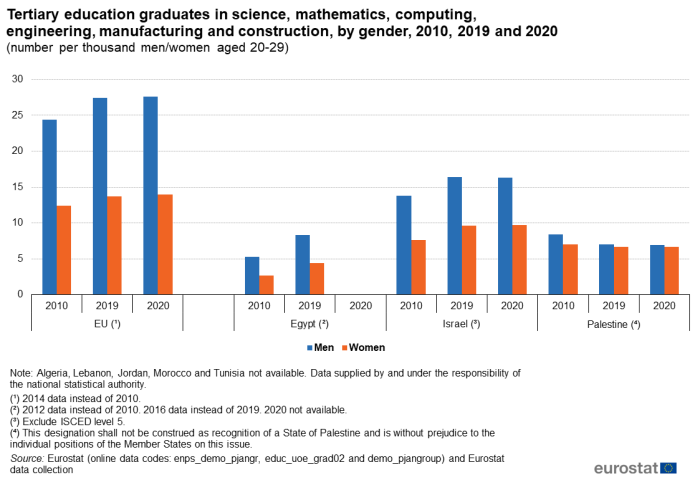
(number per thousand men/women aged 20-29)
Source: Eurostat (enps_demo_pjangr), (educ_uoe_grad02) and (demo_pjangroup) and Eurostat data collection
Data are available only for Egypt, Israel and Palestine. Among these three countries, the lowest gender gap was recorded in Palestine, where there was a 0.2 graduates per thousand persons (aged 20-29 years) difference in favour of men in 2020. This gender gap was even lower than the 1.4 graduates per thousand persons (aged 20-29 years) gender gap observed in 2010. The ratios of men and women who graduated in science, mathematics, computing, engineering, manufacturing and construction were 6.9 and 6.7 graduates per thousand persons (aged 20-29 years) in 2020, while they were higher in 2010, with 8.4 and 7.0 graduates per thousand persons (aged 20-29 years), respectively. In Egypt, the ratio of men who graduated in science, mathematics, computing, engineering, manufacturing and construction, was almost twice the ratio of women, with 8.3 and 4.4 graduates per thousand persons (aged 20-29 years), respectively in 2016 (more recent data not available). Moreover, the gender gap between 2012 (no 2010 data) and 2016 increased from 2.6 graduates per thousand persons (aged 20-29 years) difference in 2012 to 3.9 graduates per thousand persons (aged 20-29 years) in 2016. In Israel, the gender gap was rather stable over the years, however, it was the highest of the three ENP-South countries. In 2020, the ratio was 16.3 graduates per thousand persons (aged 20-29 years) for men and only 9.7 graduates per thousand persons (aged 20-29 years years) for women; resulting in a 6.6 graduates per thousand persons (aged 20-29 years) gender gap in favour of men. The gender gap was already at a similar level, though slightly lower, in 2010 with 6.2 graduates per thousand persons (aged 20-29 years) difference. In these three ENP-South countries, the ratios for men and for women were considerably lower than in the EU. In 2020, there were 27.6 male graduates in science, mathematics, computing, engineering, manufacturing and construction per thousand men (aged 20-29 years), while for women the ratio was half of that of men at 13.9 %. As a result, the gender gap in the EU was high at 13.6 graduates per thousand persons (aged 20-29 years). In 2014 (no 2010 data available), in the EU the ratio was 24.3 graduates per thousand persons (aged 20-29 years) for men and 12.4 graduates per thousand persons (aged 20-29 years) for women; resulting in a 11.9 graduates per thousand persons (aged 20-29 years) gender gap in favour of men.
Source data for tables and graphs
Data sources
The data for ENP-South countries are supplied by and under the responsibility of the national statistical authorities of each country on a voluntary basis. The data that are presented in this article result from an annual data collection cycle that has been established by Eurostat. No recent data are available from either Libya or Syria. These statistics are available free-of-charge on Eurostat's website, together with a range of different indicators covering most socio-economic areas.
Education statistics cover a range of subjects, including: expenditure, personnel, participation and attainment. The standards for international statistics on education are set by three organisations:
- the United Nations Educational, Scientific, and Cultural Organisation (UNESCO) institute for statistics (UIS);
- the Organisation for Economic Cooperation and Development (OECD);
- Eurostat, the statistical office of the European Union.
The main source of data for the EU aggregate is a joint UNESCO/OECD/Eurostat (UOE) questionnaire on education systems and this is the basis for the core components of the Eurostat database on education statistics; Eurostat also collects data on regional enrolments and foreign language learning. EU data on educational attainment are mainly provided through household surveys, in particular the EU labour force survey (LFS).
Tables in this article use the following notation:
| Value in italics | data value is forecasted, provisional or estimated and is therefore likely to change; |
| : | not available, confidential or unreliable value; |
| – | not applicable. |
Context
Each EU Member State is responsible for its own education and training systems. As such, EU policy in this area is designed to support national action and address common challenges, by providing a forum for exchanging best practices.
The strategic framework for European cooperation in education and training (known as ET 2020) was adopted by the Council in May 2009, with the following four common objectives for 2020:
- Making lifelong learning and mobility a reality
- Improving the quality and efficiency of education and training
- Promoting equity, social cohesion, and active citizenship
- Enhancing creativity and innovation, including entrepreneurship, at all levels of education and training.
Based on the mid-term stock-taking of this strategic framework, in 2015 the Council adopted new priority areas and concrete issues for further work up to 2020, as laid down in the Joint Report from the European Commission and the Council on the implementation of the strategic framework (2015/C 417/04):
- Relevant and high-quality knowledge, skills and competences developed throughout lifelong learning, focusing on learning outcomes for employability, innovation, active citizenship and well-being.
- Inclusive education, equality, equity, non-discrimination and the promotion of civic competences.
- Open and innovative education and training, including by fully embracing the digital era.
- Strong support for teachers, trainers, school leaders and other educational staff.
- Transparency and recognition of skills and qualifications to facilitate learning and labour mobility.
- Sustainable investment, quality and efficiency of education and training systems.
In 2021, a new 'Strategic framework for European cooperation in education and training towards the European Education Area and beyond (2021-2030)' was adopted by Council Resolution 2021/C 66/01. This sets the following strategic priorities:
- Improving quality, equity, inclusion and success for all in education and training.
- Making lifelong learning and mobility a reality for all.
- Enhancing competences and motivation in the education profession.
- Reinforcing European higher education.
- Supporting the green and digital transitions in and through education and training.
The European Neighbourhood Policy (ENP), launched in 2003 and developed throughout 2004, supports and fosters stability, security and prosperity in the EU's neighbourhood. The ENP was revised in 2015. The main principles of the revised policy are a tailored approach to partner countries; flexibility; joint ownership; greater involvement of EU Member States and shared responsibility. The ENP aims to deepen engagement with civil society and social partners. It offers partner countries greater access to the EU's market and regulatory framework, standards and internal agencies and programmes.
The Joint Communication on Renewed Partnership with the Southern Neighbourhood – A new Agenda for the Mediterranean, accompanied by an Economic and Investment Plan for the Southern neighbours, of 9 February 2021 further guides cooperation with the ENP-South countries.
The main objective of Euro-Mediterranean cooperation in statistics is to enable the production and dissemination of reliable and comparable data, in line with European and international norms and standards.
Reliable and comparable data are essential for evidence-based decision-making. They are needed to monitor the implementation of the agreements between the EU and the ENP-South countries, the impact of policy interventions and the reaching of the Sustainable Development Goals (SDGs).
The EU has been supporting statistical capacity building in the region for a number of years through bilateral and regional capacity-building activities. This takes the form of technical assistance to partner countries' national statistical authorities through targeted assistance programmes, such as the MEDSTAT programme and activities such as training courses, working groups and workshops, exchange of best practice and the transfer of statistical know-how. Additional information on the policy context of the ENP is provided here.
Notes
- ↑ This designation shall not be construed as recognition of a State of Palestine and is without prejudice to the individual positions of the EU Member States on this issue.
Direct access to
Books
- Euro-Mediterranean statistics — 2015 edition
- Statistics on European Neighbourhood Policy countries: South — 2020 edition
Leaflets
- Basic figures on the European Neighbourhood Policy — South countries — 2019 edition
- Basic figures on the European Neighbourhood Policy — South countries — 2020 edition
- Basic figures on the European Neighbourhood Policy — South countries — 2018 edition
- Basic figures on the European Neighbourhood Policy — South countries — 2016 edition
- Basic figures on the European Neighbourhood Policy — South countries — 2015 edition
- Labour force statistics for the Mediterranean region — 2016 edition
Factsheets
- Population and social conditions (enps_pop)
- Education (enps_educ)
- Literacy (enps_educ_lt)
- General education (enps_educ_ge)
- Expenditure on education (enps_educ_fine)
- Educational attainment level (enps_edat_lfs)
- Education (enps_educ)
- Southern European Neighbourhood Policy countries (ENP-South) (enps) (ESMS metadata file — enps_esms)